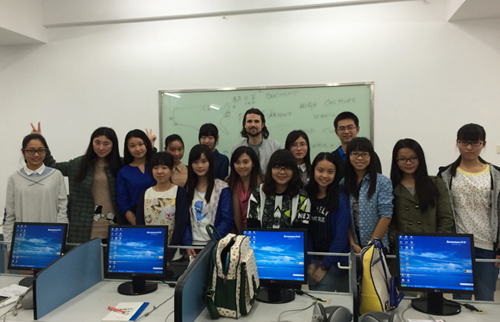Source: www.sysustudent.net
Written by: Ian J. Heuer
Edited by: Wang Dongmei
I always heard that Sun Yat-sen University had four campuses. We were told this fact during orientation and it popped up from time to time over the course of my time spend studying at SYSU. Sometimes I would hear that a classmate had visited friends on the East Campus. Once I even walked by the North Campus myself during a shopping trip through central Guangzhou. But for me, life always revolved around the historic South Campus in Guangzhou’s Haizhu district. So when I got an unexpected invitation to help teach a class at the university’s campus in nearby Zhuhai, I jumped on the chance to see another side of the university. The next thing I knew, I was climbing aboard the shuttle bus kicking off the ninety minute journey south to Zhuhai.
The teaching building on Zhuhai Campus
After arriving on campus the first thing that struck me was the extremely relaxed vibe. Guangzhou is always a rush and blur of activity, and I always thought that SYSU’s South Campus was an extreme exception. Its stately lawns, wide open spaces, and historic brick buildings lend the South Campus an air of subdued elegance. On the Zhuhai campus, the atmosphere was much different. The pace of life was unhurried, and there was an unassuming feeling to everything. In Guangzhou, the shrubs and trees are sculpted into artistic beauty; in Zhuhai, they are rough-edged and untamed. In Guangzhou, the lawns are immaculately maintained showpieces; in Zhuhai, they are spaces for communal activity. In Guangzhou, students clad in business attire or graduation gowns can be seen flitting to and fro: in Zhuhai, hoodies, jeans, and leisurely strolls seem to be norm.
The library on Zhuhai Campus
Beyond the atmosphere, the layout of the campus was also much different that I was used to on the South Campus. All classes are held in a single building, which I was repeatedly told is the longest academic building in any university in Asia. Whereas the buildings on the South Campus are spread out and hidden in the subtropical canopies, the buildings in Zhuhai stand out like monuments. Another example is the library, which is a remarkable piece of architecture. Two massive buildings branch out from a single narrow gap, forming symmetrical towers reminiscent of two stacks of books. Between them, a narrow path runs up a hillside. Beyond the human-made aspects of the campus, the natural scenery is also breathtaking. In Chinese aesthetics, a scene that combines verdant mountains and tranquil waters is the pinnacle of natural beauty. This is achieved on the Zhuhai campus, where rolling green hills are surrounded by pristine lakes. Not to mention the sea, which is visible from campus high-points.

The class I helped teach at Zhuhai Campus
The class I helped teach was given to undergraduates studying English. I chose to talk about Andy Warhol, the American artist. I was quick to discover that the most impressive thing about Zhuhai Campus was not the atmosphere or the scenery, but the students. They were all fluent in English and actively engaged in discussion about not only Warhol but the nature of contemporary art and the way that societies influence art and aesthetics. I came away from my trip having learned a lot, and I hope to get another chance to visit Zhuhai in the near future.



